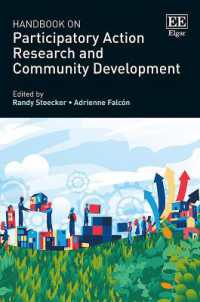- ホーム
- > 洋書
- > 英文書
- > Science / Mathematics
Full Description
This book contains the edited papers presented at the Third International Conference on High Performance Structures and Materials and it addresses issues involving advanced types of structures, particularly those based on new concepts or new types of materials. Particular emphasis is placed on intelligent 'smart structures' as well as the application of computational methods to model, control and manage these structures and materials. The book covers topics such as: Damage and Fracture Mechanics; Composite Materials and Structures; Optimal Design; Adhesion and Adhesives; Natural Fibre Composites; Failure Criteria of FRP; Non-linear Behaviour of FRP Structures; Material Characterization; High Performance Materials; High Performance Concretes; Aerospace Structures; Reliability of Structures; Ceramics in Engineering.
Contents
Section 1: Conceptual design and structural analysis Conceptual design of lightweight structures:the role of morphological indicators and the structural index; Influence of dynamic loads on the optimum design of trusses; Modular grid-based design concept for fibre reinforced composite shells; Influence of stiffness constraints on optimal design of trusses using morphological indicators; Variations in form and stress behaviour of a V-shaped membrane in a foldable structure Section 2: Composite materials and structures A new composite material based on natural fibres and a thermoset: technology, applications and properties; Experimental test of threaded steel rods glued-in hardwood with epoxy; Predicting the mechanical behaviour of large composite rocket motor cases; Micromechanical modeling of random or imperfect composites; Flexural behaviour of ferrocement roof panels; Finite element modeling of actuated fibre composites; CFRP strengthening of prefabricated timber panel walls; Evaluation of the structural integrity of a sandwich composite train roof structure; Measurement of the fiber stress distribution during pull-out test by means of micro-Raman spectroscopy and FEM analysis Section 3: Natural fibre composites Effect of surface treatment to tensile static and creep properties for jute fiber reinforced composite; Effects of forming conditions on mechanical properties of resinless bamboo composites; Compression moulding of jute fabric reinforced thermoplastic composites based on PLA non-woven fabric; Quality control of fibers end-milled from bamboo pipe using spiral tool path; Characteristic behaviors of CFRP and GFRP at cryogenic temperature under static and cyclic loadings; Mechanical properties of loosing natural fiber reinforced polypropylene Section 4: Material and mechanical characterisation Identification of strain-rate sensitivity parameters of steel sheet by genetic algorithm optimisation; Mechanical characterisation of a viscous-elastic plastic material, sensitive to hydrostatic pressure and temperature; Identification of the material properties of composite beams: inverse method approach; Full-field optical measurement for material parameter identification with inverse methods; Multiaxial characterization of the mechanical behaviour of aluminium foam; Characterisation of the high strain rate properties of Advanced High Strength Steels; valuation of bond strength in Roller Compacted Concrete under various normal pressures; High performance fibres and the mechanical attributes of cut resistant structures made therewith; The study of surface oxidation of tin(II) fluoride and chloride fluoride materials by Mossbauer spectroscopy: to oxidize or not to oxidize, that is the question; Study of double ionic disorder (cationic and anionic) and disorder of two kinds of tin(II) (ionic and covalent) within the same material: the incredibly complex Ba1-xSnxCl1+yF1-y solid solution and its study by Mossbauer spectroscopy; Study on fatigue and energy-dissipation properties of nanolayered Cu/Nb thin films; Advances in computational modeling through the use of higher-level microstructure characterization; Deformation of aluminum alloys AD-1, AMg-6 and D-16 at dynamic compression and temperatures of 25-250 C; X-ray residual stress measurements on plasma sprayed molybdenum coatings; Compressive residual stress generation process by laser peening without pre-coating; The scale effect of roughness in contact problems Section 5: High performance concretes Copper slag as fine aggregate for high performance concrete; Application of FRC in tunnel reinforcement; Innovative procedure to produce high performance pretensioned concrete girders combining high strength concrete and normal or special concrete types; Properties of high performance concrete: the effect of cracks; Seismic upgrading of square and rectangular RC columns using FRP wrapping; Arch bridge made of reactive powder concrete; Elastic and inelastic seismic response comparison of reinforced concrete buildings with normal resistance concrete and with high resistance concrete; The strength effects of synthetic zeolites on properties of high performance concrete; Behaviour model and experimental study for the torsion of reinforced concrete members; A study on use of blended ferrocement: a high performance material for repair/strengthening of brick masonry columns Section 6: Damage and fracture mechanics Crush behaviour of open cellular lattice structures manufactured using selective laser melting; Stress intensity factors for cracked cold-drawn steel wires under tensile loading; Void growth and damage ahead of a crack in pressure-sensitive dilatant polymers; An orthotropic damage model for crash simulation of composites; Ring-shaped crack propagation in a cylinder under nonsteady cooling; Investigation of the hygrothermal performance of wooden beam ends embedded in inside insulated outside walls; Bond repair of cracked beams; Microtexture and nanoindentation study of delamination cracking in Al-Cu-Li-X alloys; A contribution to the rehabilitation of reinforced concrete structures by non-destructive electrochemical methods Section 7: Adhesion and adhesives Timber specimens parametrized design for numerical analysis; Theory of the elasticity of the materials of the second order Section 8: Optimal design Optimal design of fibre reinforced tubular structures; MINLP optimization of steel frames; Optimization of timber trusses considering joint flexibility; The Hendrickx-Vanwalleghem design strategy; The optimization of a truss facade; MINLP optimization of the single-storey industrial building steel structure; Genetically optimised placement of piezoelectric sensor arrays: linear and nonlinear transient analysis; Numerical analysis of the process of trapezoidal thread rolling; Three-dimensional limit analysis of ancient masonry buildings with rigid block models Section 9: Reliability of structures Analysis of diffusional stress relaxation in submicron Cu interconnect structures using the model with enhanced vacancy diffusivity in grain boundary region; Application of fuzzy sets to structural reliability of existing structures; Non-linear response of combined system, 3D wall panels and bending steel frame subjected to seismic loading








